The Spatiotemporal Fluctuations of Extreme Rainfall and Their Potential Influencing Factors in Sichuan Province, China, from 1970 to 2022
Abstract
1. Introduction
2. Study Area, Data, and Methods
2.1. Study Area
2.2. Data
2.3. Methods
2.3.1. Definition of EPIs
2.3.2. Linear Trend Analysis and M-K Significance Test
2.3.3. Cumulative Anomaly Method and Pettitt Test
2.3.4. R/S Analysis
2.3.5. Pearson Correlation Analysis and Wavelet Transform
3. Results
3.1. Changes in EPIs
3.1.1. Trend Changes in EPIs
3.1.2. Seasonal Changes in EPIs
3.1.3. Mutational Analysis of EPIs
3.1.4. Future Trends in EPIs
3.2. EPIs Correlation Analysis
3.2.1. Correlation of EPIs with PRCPTOT
3.2.2. Influence of Geographic Factors on EPIs
3.2.3. Influence of Meteorological Factors on EPIs
4. Discussion
5. Conclusions
- (1)
- On the time scale studied, the precipitation indices in Sichuan Province, except for CWDs, show different degrees of increasing trends during the 1970–2022 period, with the SDII showing the most significant increase (p < 0.05). The increasing trends of these precipitation indices were notably larger in summer than in other seasons, with the R95P index showing the largest increase in summer at a rate of 0.57 mm per decade.
- (2)
- The cumulative anomaly method and the Pettitt test identified 2012 as the change point for the R5mm, R10mm, and R20mm indices, all of which passed the 95% significance threshold. R/S analysis revealed that the Hurst indices for all EPIs, except for CDDs, exceeded 0.5, indicating persistence. Considering historical trends in Sichuan Province, the future trajectories of the remaining EPIs are expected to align with past patterns, exhibiting an overall increasing trend. Consequently, Sichuan Province is likely to encounter heightened risks of heavy rainfall and flooding events in the future.
- (3)
- On a spatial scale, some of the extreme precipitation indices (e.g., R95P) in the Chengdu region show significant decreasing trends, and this phenomenon is particularly prominent in the spatial distribution. Although the increase in the number of consecutive drought days (CDDs) is more significant in southeastern Sichuan, and the total precipitation amount (PRCPTOT) in the whole region generally shows an increasing trend, the decrease in extreme precipitation events in Chengdu still needs to be emphasized. This result suggests that there is spatial heterogeneity in the response of different precipitation indicators in the context of regional climate change: the enhanced trend of precipitation in the northwest is obvious, while extreme precipitation in the Chengdu Plain shows the opposite decreasing characteristics. It is recommended that such regional differences be adequately considered in climate adaptation planning, especially the impacts of decreasing precipitation extremes on urban flood control and water resource management.
- (4)
- Correlation analysis reveals that most indices are significantly positively correlated with total precipitation (p < 0.01), except for CDDs, which shows a weak correlation with total precipitation. Among these indices, R20mm has the most pronounced effects on total precipitation.
- (5)
- Regarding geographic factors, most precipitation indices are significantly positively correlated with longitude, negatively correlated with latitude, and negatively correlated with elevation, except for CDDs. This pattern implies that precipitation generally increases from west to east and decreases as one moves northward in Sichuan Province, likely because the eastern part of the Sichuan Basin is closer to the ocean. Drought conditions are more severe at higher altitudes (e.g., the plateau zone in western Sichuan Province), possibly because mountainous terrain obstructs precipitation formation and because cooler temperatures reduce the likelihood of water vapor condensation.
- (6)
- Concerning meteorological influences, stronger correlations are observed between EPIs and factors such as the AMO, Niño 3.4, and SCSSMI. In Sichuan Province, precipitation intensity exhibits a tendency to rise alongside elevated sea surface temperatures in the North Atlantic Ocean. Conversely, as summer wind intensity over the South China Sea strengthens, the occurrence or severity of extreme precipitation events appears to diminish.
Author Contributions
Funding
Data Availability Statement
Conflicts of Interest
Appendix A
| Abbreviation | Full Form |
|---|---|
| L | Low-elevation |
| M | Mid-elevation |
| H-M | High-to-mid elevation |
| H | High-elevation |
| E | Extreme-elevation |
| EPIs | Extreme Precipitation Indices |
| WCRP | World Climate Research Program |
| ETCCDI | Expert Team on Climate Change Detection and Indices |
| ECMWF | European Centre for Medium-Range Weather Forecasts |
| PSL | NOAA Physical Sciences Laboratory |
| NAO | North Atlantic Oscillation |
| PDO | Pacific Decadal Oscillation |
| AO | Arctic Oscillation |
| AMO | Atlantic Multidecadal Oscillation |
| Niño 3.4 | East Central Tropical Pacific SST |
| SOI | Southern Oscillation Index |
| MEI | Multivariate ENSO Index |
| EASMI | East Asian Summer Monsoon Index |
| SCSSMI | South China Sea Summer Monsoon Index |
| ENSO | El Niño–Southern Oscillation |
| EASM | East Asian summer monsoon |
| SST | Sea Surface Temperature |
| OLS | Ordinary Least Squares |
| M-K | Mann–Kendall |
| XWT | Crossed Wavelet Transform |
| WTC | Wavelet Coherence Analysis |
| Number | Indices | Description Name | Definition | Units |
|---|---|---|---|---|
| 1 | CDD | Consecutive dry days | Maximum number of consecutive days when RR < 1 mm | days |
| 2 | CWD | Consecutive wet days | Maximum number of consecutive days when RR ≥ 1 mm | days |
| 3 | SDII | Simple daily intensity index | Annual total precipitation divided by the number of wet days (defined as precipitation ≥ 1 mm) in a year | mm/days |
| 4 | RX1day | Max 1-day precipitation amount | Monthly maximum 1-day precipitation | mm |
| 5 | RX5day | Max 5-day precipitation amount | Monthly maximum consecutive 5-day precipitation | mm |
| 6 | R5mm | Number of days above 5 mm | Annual count of days when precipitation ≥ 5 mm | days |
| 7 | R10mm | Number of heavy precipitation days | Annual count of days when precipitation ≥ 10 mm | days |
| 8 | R20mm | Number of very heavy precipitation days | Annual count of days when precipitation ≥ 20 mm | days |
| 9 | PRCPTOT | Annual total wet-day precipitation | Annual total precipitation on wet days (RR ≥ 1 mm) | mm |
| 10 | R95P | Very wet days | Annual total precipitation when daily precipitation > 95th percentile | mm |
| 11 | R99P | Extremely wet days | Annual total precipitation when daily precipitation > 99th percentile | mm |
| Indices | CDD | CWD | SDII | RX1day | RX5day | R5mm | R10mm | R20mm | PRCPTOT | R95P | R99P |
|---|---|---|---|---|---|---|---|---|---|---|---|
| Point of Mutation | 2008 (p > 0.05) | 2016 (p > 0.05) | 1998 | 1980 (p > 0.05) | 2007 (p > 0.05) | 2012 | 2012 | 2012 | 2012 | 2009 | 2009 (p > 0.05) |

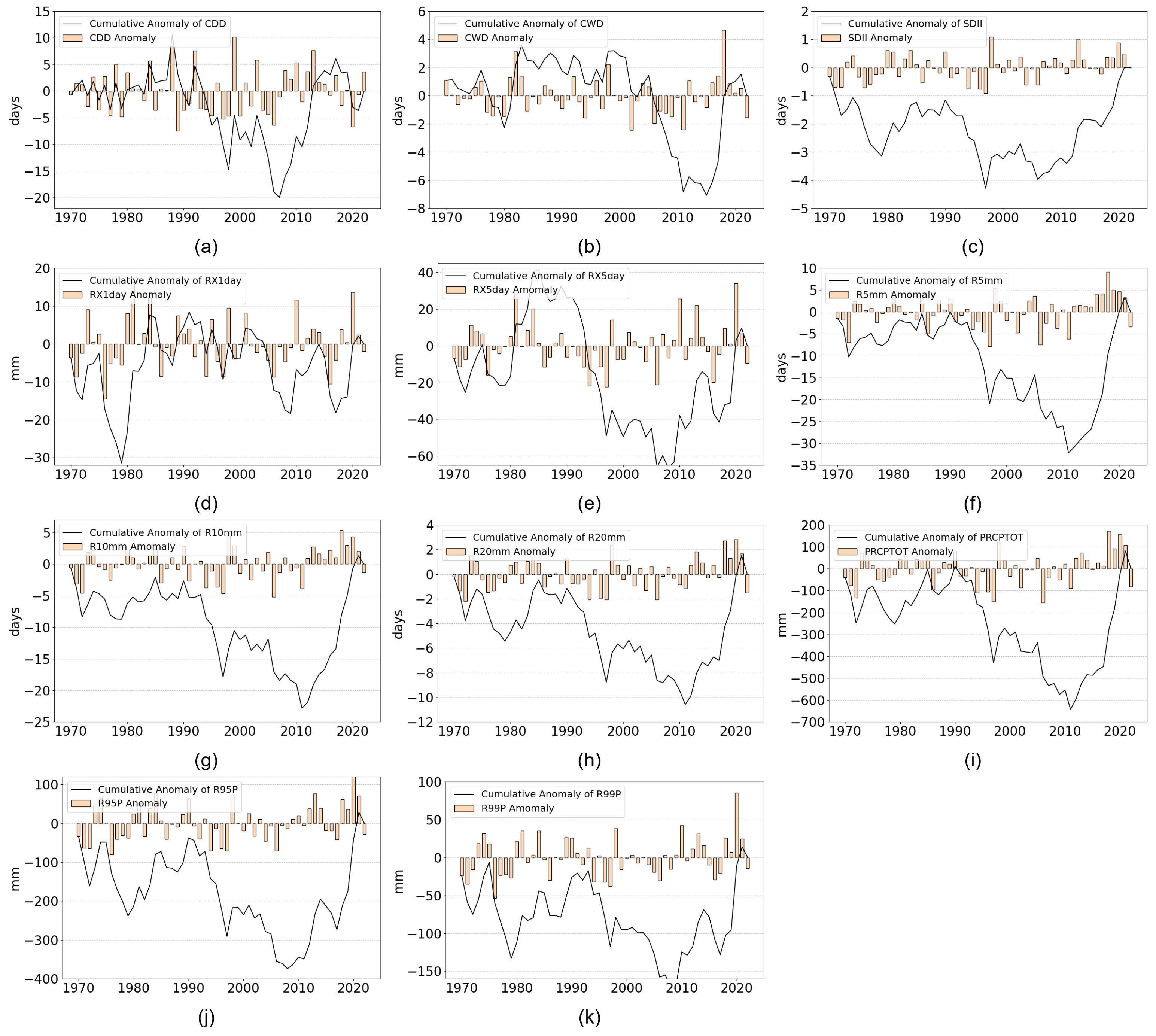
References
- Morss, R.E.; Wilhelmi, O.V.; Meehl, G.A.; Dilling, L. Improving societal outcomes of extreme weather in a changing climate: An integrated perspective. Annu. Rev. Environ. Resour. 2011, 36, 1–25. [Google Scholar] [CrossRef]
- Kron, W.; Löw, P.; Kundzewicz, Z.W. Changes in risk of extreme weather events in Europe. Environ. Sci. Policy 2019, 100, 74–83. [Google Scholar] [CrossRef]
- Grotjahn, R.; Black, R.; Leung, R.; Wehner, M.F.; Barlow, M.; Bosilovich, M.; Gershunov, A.; Gutowski, W.J.; Gyakum, J.R.; Katz, R.W. North American extreme temperature events and related large scale meteorological patterns: A review of statistical methods, dynamics, modeling, and trends. Clim. Dyn. 2016, 46, 1151–1184. [Google Scholar] [CrossRef]
- Mukherjee, S.; Aadhar, S.; Stone, D.; Mishra, V. Increase in extreme precipitation events under anthropogenic warming in India. Weather Clim. Extrem. 2018, 20, 45–53. [Google Scholar] [CrossRef]
- Vogel, E.; Donat, M.G.; Alexander, L.V.; Meinshausen, M.; Ray, D.K.; Karoly, D.; Meinshausen, N.; Frieler, K. The effects of climate extremes on global agricultural yields. Environ. Res. Lett. 2019, 14, 054010. [Google Scholar] [CrossRef]
- Bouwer, L.M. Observed and projected impacts from extreme weather events: Implications for loss and damage. In Loss and Damage from Climate Change: Concepts, Methods and Policy Options; Springer: Berlin/Heidelberg, Germany, 2019; pp. 63–82. [Google Scholar]
- Brunet, G.; Parsons, D.B.; Ivanov, D.; Lee, B.; Bauer, P.; Bernier, N.B.; Bouchet, V.; Brown, A.; Busalacchi, A.; Flatter, G.C. Advancing weather and climate forecasting for our changing world. Bull. Am. Meteorol. Soc. 2023, 104, E909–E927. [Google Scholar] [CrossRef]
- Wang, L.; Chen, S.; Zhu, W.; Ren, H.; Zhang, L.; Zhu, L. Spatiotemporal variations of extreme precipitation and its potential driving factors in China’s North-South Transition Zone during 1960–2017. Atmos. Res. 2021, 252, 105429. [Google Scholar] [CrossRef]
- Alexander, L.V.; Fowler, H.J.; Bador, M.; Behrangi, A.; Donat, M.G.; Dunn, R.; Funk, C.; Goldie, J.; Lewis, E.; Rogé, M. On the use of indices to study extreme precipitation on sub-daily and daily timescales. Environ. Res. Lett. 2019, 14, 125008. [Google Scholar] [CrossRef]
- Zhao, J.; Gan, T.Y.; Zhang, G.; Zhang, S. Projected changes of precipitation extremes in North America using CMIP6 multi-climate model ensembles. J. Hydrol. 2023, 621, 129598. [Google Scholar] [CrossRef]
- Guo, E.; Zhang, J.; Wang, Y.; Quan, L.; Zhang, R.; Zhang, F.; Zhou, M. Spatiotemporal variations of extreme climate events in Northeast China during 1960–2014. Ecol. Indic. 2019, 96, 669–683. [Google Scholar] [CrossRef]
- Sun, Q.; Zhang, X.; Zwiers, F.; Westra, S.; Alexander, L.V. A global, continental, and regional analysis of changes in extreme precipitation. J. Clim. 2021, 34, 243–258. [Google Scholar] [CrossRef]
- Du, H.; Alexander, L.V.; Donat, M.G.; Lippmann, T.; Srivastava, A.; Salinger, J.; Kruger, A.; Choi, G.; He, H.S.; Fujibe, F. Precipitation from persistent extremes is increasing in most regions and globally. Geophys. Res. Lett. 2019, 46, 6041–6049. [Google Scholar] [CrossRef]
- Nayak, S.; Dairaku, K.; Takayabu, I.; Suzuki-Parker, A.; Ishizaki, N.N. Extreme precipitation linked to temperature over Japan: Current evaluation and projected changes with multi-model ensemble downscaling. Clim. Dyn. 2018, 51, 4385–4401. [Google Scholar] [CrossRef]
- Zeder, J.; Fischer, E.M. Observed extreme precipitation trends and scaling in Central Europe. Weather. Clim. Extrem. 2020, 29, 100266. [Google Scholar] [CrossRef]
- Picard, C.J.; Winter, J.M.; Cockburn, C.; Hanrahan, J.; Teale, N.G.; Clemins, P.J.; Beckage, B. Twenty-first century increases in total and extreme precipitation across the Northeastern USA. Clim. Chang. 2023, 176, 72. [Google Scholar] [CrossRef]
- Vincent, L.A.; Mekis, É. Changes in daily and extreme temperature and precipitation indices for Canada over the twentieth century. In Data, Models and Analysis; Routledge: Lodon, UK, 2019; pp. 61–77. [Google Scholar]
- Gu, X.; Ye, L.; Xin, Q.; Zhang, C.; Zeng, F.; Nerantzaki, S.D.; Papalexiou, S.M. Extreme precipitation in China: A review on statistical methods and applications. Adv. Water Resour. 2022, 163, 104144. [Google Scholar] [CrossRef]
- Shi, J.; Cui, L.; Wen, K.; Tian, Z.; Wei, P.; Zhang, B. Trends in the consecutive days of temperature and precipitation extremes in China during 1961–2015. Environ. Res. 2018, 161, 381–391. [Google Scholar] [CrossRef] [PubMed]
- Cheng, X.; Wan, H.; Huang, S.; Li, C.; Zhang, H. Lessons learned from the 2016 Yangtze River flood in Anhui province, China. Int. J. River Basin Manag. 2018, 16, 307–314. [Google Scholar] [CrossRef]
- Guo, X.; Cheng, J.; Yin, C.; Li, Q.; Chen, R.; Fang, J. The extraordinary Zhengzhou flood of 7/20, 2021: How extreme weather and human response compounding to the disaster. Cities 2023, 134, 104168. [Google Scholar] [CrossRef]
- Wei, K.; Ouyang, C.; Duan, H.; Li, Y.; Chen, M.; Ma, J.; An, H.; Zhou, S. Reflections on the catastrophic 2020 Yangtze River Basin flooding in southern China. Innovation 2020, 1, 100038. [Google Scholar] [CrossRef] [PubMed]
- Wei, F.; Liu, D.; Liang, Z.; Wang, Y.; Shen, J.; Wang, H.; Zhang, Y.; Wang, Y.; Li, S. Spatial heterogeneity and impact scales of driving factors of precipitation changes in the Beijing-Tianjin-Hebei region, China. Front. Environ. Sci. 2023, 11, 1161106. [Google Scholar] [CrossRef]
- Du, H.; Xia, J.; Yan, Y.; Lu, Y.; Li, J. Spatiotemporal Variations of Extreme Precipitation in Wuling Mountain Area (China) and Their Connection to Potential Driving Factors. Sustainability 2022, 14, 8312. [Google Scholar] [CrossRef]
- Zhang, H.; Zhang, R.; Ju, Q.; Kong, G.; Xie, Y.; He, J.; Huang, Y. Analysis of extreme precipitation variation characteristics and the influencing factors in the Yunnan-Guizhou Plateau Region, China. Sustainability 2023, 15, 14735. [Google Scholar] [CrossRef]
- Li, Z.; Yang, H.; Jia, M. Factors Affecting the Spatiotemporal Variation of Precipitation in the Songhua River Basin of China. Water 2024, 16, 2. [Google Scholar] [CrossRef]
- Wei, W.; Zou, S.; Duan, W.; Chen, Y.; Li, S.; Zhou, Y. Spatiotemporal variability in extreme precipitation and associated large-scale climate mechanisms in Central Asia from 1950 to 2019. J. Hydrol. 2023, 620, 129417. [Google Scholar] [CrossRef]
- Tao, L.; Liang, X.S.; Cai, L.; Zhao, J.; Zhang, M. Relative contributions of global warming, AMO and IPO to the land precipitation variabilities since 1930s. Clim. Dyn. 2021, 56, 2225–2243. [Google Scholar] [CrossRef]
- Ouyang, R.; Liu, W.; Fu, G.; Liu, C.; Hu, L.; Wang, H. Linkages between ENSO/PDO signals and precipitation, streamflow in China during the last 100 years. Hydrol. Earth Syst. Sci. 2014, 18, 3651–3661. [Google Scholar] [CrossRef]
- Li, B.; Chen, Y.; Chen, Z.; Xiong, H.; Lian, L. Why does precipitation in northwest China show a significant increasing trend from 1960 to 2010? Atmos. Res. 2016, 167, 275–284. [Google Scholar] [CrossRef]
- Zhao, G.; Mu, X.; Hörmann, G.; Fohrer, N.; Xiong, M.; Su, B.; Li, X. Spatial patterns and temporal variability of dryness/wetness in the Yangtze River Basin, China. Quat. Int. 2012, 282, 5–13. [Google Scholar] [CrossRef]
- Li, J.; Zhao, Y.; Iqbal, J. Variation patterns of extreme precipitation and relation to ocean-atmospheric climate in Sichuan province China from 1961 to 2017. Theor. Appl. Climatol. 2019, 137, 3009–3026. [Google Scholar] [CrossRef]
- Yang, X.y.; Zhang, S.b.; Lyu, Y.q.; Zhao, Y.; Lyu, S.h. Characteristics and future projections of summer extreme precipitation in Sichuan Province, China. J. Mt. Sci. 2020, 17, 1696–1711. [Google Scholar] [CrossRef]
- Han, J.; Miao, C.; Gou, J.; Zheng, H.; Zhang, Q.; Guo, X. A new daily gridded precipitation dataset for the Chinese mainland based on gauge observations. Earth Syst. Sci. Data 2023, 15, 3147–3161. [Google Scholar] [CrossRef]
- Zhang, Q.; Singh, V.P.; Li, J.; Chen, X. Analysis of the periods of maximum consecutive wet days in China. J. Geophys. Res. Atmos. 2011, 116, D23106. [Google Scholar] [CrossRef]
- Cao, F.; Gao, T.; Dan, L.; Ma, Z.; Chen, X.; Zou, L.; Zhang, L. Synoptic-scale atmospheric circulation anomalies associated with summertime daily precipitation extremes in the middle–lower reaches of the Yangtze River Basin. Clim. Dyn. 2019, 53, 3109–3129. [Google Scholar] [CrossRef]
- Gao, J.; Zhang, Y.; Li, X.; Li, H.; Gao, Z.; Ji, M. The Extreme Rainfall Characteristics and Terrace Greenhouse Erosion Control in Climate Change and Human Impact in Hilly and Gully Region of the Loess Plateau in China. In Proceedings of the Climate Change Impacts on Hydrological Processes and Sediment Dynamics: Measurement, Modelling and Management: The Proceedings of The Second International Young Scientists Forum on Soil and Water Conservation and ICCE Symposium 2018, Moscow, Russia, 27–31 August 2018; Springer: Berlin/Heidelberg, Germany, 2018; pp. 43–46. [Google Scholar]
- Zhang, Q.; Zheng, Y.; Singh, V.P.; Luo, M.; Xie, Z. Summer extreme precipitation in eastern China: Mechanisms and impacts. J. Geophys. Res. Atmos. 2017, 122, 2766–2778. [Google Scholar] [CrossRef]
- Zhang, Y.; Chu, X.; Yang, S.; Guo, C. Climate change in north Xinjiang in recent 56 years. Arid Zone Res. 2019, 36, 212–219. [Google Scholar]
- Ding, Z.; Wang, Y.; Lu, R. An analysis of changes in temperature extremes in the Three River Headwaters region of the Tibetan Plateau during 1961–2016. Atmos. Res. 2018, 209, 103–114. [Google Scholar] [CrossRef]
- Mann, H.B. Nonparametric tests against trend. Econom. J. Econom. Soc. 1945, 13, 245–259. [Google Scholar] [CrossRef]
- Kendall, M.G. Rank Correlation Methods, 4th ed.; Griffin: London, UK, 1948. [Google Scholar]
- Du, H.; Xia, J.; Zeng, S. Regional frequency analysis of extreme precipitation and its spatio-temporal characteristics in the Huai River Basin, China. Nat. Hazards 2014, 70, 195–215. [Google Scholar] [CrossRef]
- Song, X.; Zhang, J.; Zou, X.; Zhang, C.; AghaKouchak, A.; Kong, F. Changes in precipitation extremes in the Beijing metropolitan area during 1960–2012. Atmos. Res. 2019, 222, 134–153. [Google Scholar] [CrossRef]
- Liu, S.; Huang, S.; Huang, Q.; Xie, Y.; Leng, G.; Luan, J.; Song, X.; Wei, X.; Li, X. Identification of the non-stationarity of extreme precipitation events and correlations with large-scale ocean-atmospheric circulation patterns: A case study in the Wei River Basin, China. J. Hydrol. 2017, 548, 184–195. [Google Scholar] [CrossRef]
- Han, Y.; Tian, X. Significant increase in humidity since 2003 in Qinghai Province, China: Evidence from annual and seasonal precipitation. Environ. Monit. Assess. 2023, 195, 1549. [Google Scholar] [CrossRef]
- Barbu, N.; Burada, C.; Stefan, S.; Georgescu, F. Changes in the large-scale atmospheric circulation over Romania between 1961 and 2010 on seasonal basis. Acta Geophys. 2016, 64, 510–520. [Google Scholar] [CrossRef][Green Version]
- Uliana, E.M.; Silva, D.D.d.; Uliana, E.M.; Rodrigues, B.S.; Corrêdo, L.d.P. Análise de tendência em séries históricas de vazão e precipitação: Uso de teste estatístico não paramétrico. Rev. Ambiente Água 2015, 10, 82–88. [Google Scholar]
- Zhang, Y.; Li, C.; Wang, L.; Wu, L.; Wei, J. Application and comparison of several test methods for changepoints diagnosis in streamflow variations. Water Resour. Hydro. Eng 2020, 51, 38–47. [Google Scholar]
- Hurst, H.E. Long-term storage capacity of reservoirs. Trans. Am. Soc. Civ. Eng. 1951, 116, 770–799. [Google Scholar] [CrossRef]
- Li, X.; Zhang, K.; Gu, P.; Feng, H.; Yin, Y.; Chen, W.; Cheng, B. Changes in precipitation extremes in the Yangtze River Basin during 1960–2019 and the association with global warming, ENSO, and local effects. Sci. Total. Environ. 2021, 760, 144244. [Google Scholar] [CrossRef]
- Szolgayova, E.; Parajka, J.; Blöschl, G.; Bucher, C. Long term variability of the Danube River flow and its relation to precipitation and air temperature. J. Hydrol. 2014, 519, 871–880. [Google Scholar] [CrossRef]
- Rathinasamy, M.; Agarwal, A.; Sivakumar, B.; Marwan, N.; Kurths, J. Wavelet analysis of precipitation extremes over India and teleconnections to climate indices. Stoch. Environ. Res. Risk Assess. 2019, 33, 2053–2069. [Google Scholar] [CrossRef]
- Jiang, R.; Cui, X.; Lin, J.; Tian, J. 40-year statistics of warm-season extreme hourly precipitation over Southwest China. J. Appl. Meteorol. Climatol. 2023, 62, 1891–1908. [Google Scholar] [CrossRef]
- Gimeno, L.; Dominguez, F.; Nieto, R.; Trigo, R.; Drumond, A.; Reason, C.J.; Taschetto, A.S.; Ramos, A.M.; Kumar, R.; Marengo, J. Major mechanisms of atmospheric moisture transport and their role in extreme precipitation events. Annu. Rev. Environ. Resour. 2016, 41, 117–141. [Google Scholar] [CrossRef]
- Zhao, Y. A study on the heavy-rain-producing mesoscale convective system associated with diurnal variation of radiation and topography in the eastern slope of the western Sichuan plateau. Meteorol. Atmos. Phys. 2015, 127, 123–146. [Google Scholar] [CrossRef]
- Vujovic, S.; Haddad, B.; Karaky, H.; Sebaibi, N.; Boutouil, M. Urban heat island: Causes, consequences, and mitigation measures with emphasis on reflective and permeable pavements. CivilEng 2021, 2, 459–484. [Google Scholar] [CrossRef]
- Tong, S.; Li, X.; Zhang, J.; Bao, Y.; Bao, Y.; Na, L.; Si, A. Spatial and temporal variability in extreme temperature and precipitation events in Inner Mongolia (China) during 1960–2017. Sci. Total. Environ. 2019, 649, 75–89. [Google Scholar] [CrossRef]
- Zhai, P.; Yu, R.; Guo, Y.; Li, Q.; Ren, X.; Wang, Y.; Xu, W.; Liu, Y.; Ding, Y. The strong El Niño of 2015/16 and its dominant impacts on global and China’s climate. J. Meteorol. Res. 2016, 30, 283–297. [Google Scholar] [CrossRef]
- Zhang, Q.; Gu, X.; Li, J.; Shi, P.; Singh, V.P. The impact of tropical cyclones on extreme precipitation over coastal and inland areas of China and its association to ENSO. J. Clim. 2018, 31, 1865–1880. [Google Scholar] [CrossRef]
- Lv, A.; Fan, L.; Zhang, W. Impact of ENSO events on droughts in China. Atmosphere 2022, 13, 1764. [Google Scholar] [CrossRef]
- Zhang, Y.; Zhou, W.; Wang, X.; Wang, X.; Zhang, R.; Li, Y.; Gan, J. IOD, ENSO, and seasonal precipitation variation over Eastern China. Atmos. Res. 2022, 270, 106042. [Google Scholar] [CrossRef]
- Li, S.; Ni, M.; Mao, R.; Bush, R.T. Riverine CO2 supersaturation and outgassing in a subtropical monsoonal mountainous area (Three Gorges Reservoir Region) of China. J. Hydrol. 2018, 558, 460–469. [Google Scholar] [CrossRef]
- Wu, J.; Liu, Q.; Cui, Q.; Xu, D.; Wang, L.; Shen, C.; Chu, G.; Liu, J. Shrinkage of East Asia Winter Monsoon associated with increased ENSO events since the mid-Holocene. J. Geophys. Res. Atmos. 2019, 124, 3839–3848. [Google Scholar] [CrossRef]
- Knight, J.R.; Folland, C.K.; Scaife, A.A. Climate impacts of the Atlantic multidecadal oscillation. Geophys. Res. Lett. 2006, 33, L17706. [Google Scholar] [CrossRef]
- Zhu, L.; Cooper, D.J.; Han, S.; Yang, J.; Zhang, Y.; Li, Z.; Zhao, H.; Wang, X. Influence of the atlantic multidecadal oscillation on drought in northern Daxing’an Mountains, Northeast China. Catena 2021, 198, 105017. [Google Scholar] [CrossRef]
- Liu, H.; Zhou, T.; Zhu, Y.; Lin, Y. The strengthening East Asia summer monsoon since the early 1990s. Chin. Sci. Bull. 2012, 57, 1553–1558. [Google Scholar] [CrossRef]
- Chen, D.; Zhou, F.; Dong, Z.; Zeng, A.; Ou, T.; Fang, K. A tree-ring δ18O based reconstruction of East Asia summer monsoon over the past two centuries. PLoS ONE 2020, 15, e0234421. [Google Scholar] [CrossRef] [PubMed]
- Trenberth, K.E. Changes in precipitation with climate change. Clim. Res. 2011, 47, 123–138. [Google Scholar] [CrossRef]
- Sharma, A.; Wasko, C.; Lettenmaier, D.P. If precipitation extremes are increasing, why aren’t floods? Water Resour. Res. 2018, 54, 8545–8551. [Google Scholar] [CrossRef]
- Seneviratne, S.I.; Zhang, X.; Adnan, M.; Badi, W.; Dereczynski, C.; Luca, A.D.; Ghosh, S.; Iskandar, I.; Kossin, J.; Lewis, S. Weather and Climate Extreme Events in a Changing Climate; Cambridge University Press: Cambridge, UK, 2021. [Google Scholar]
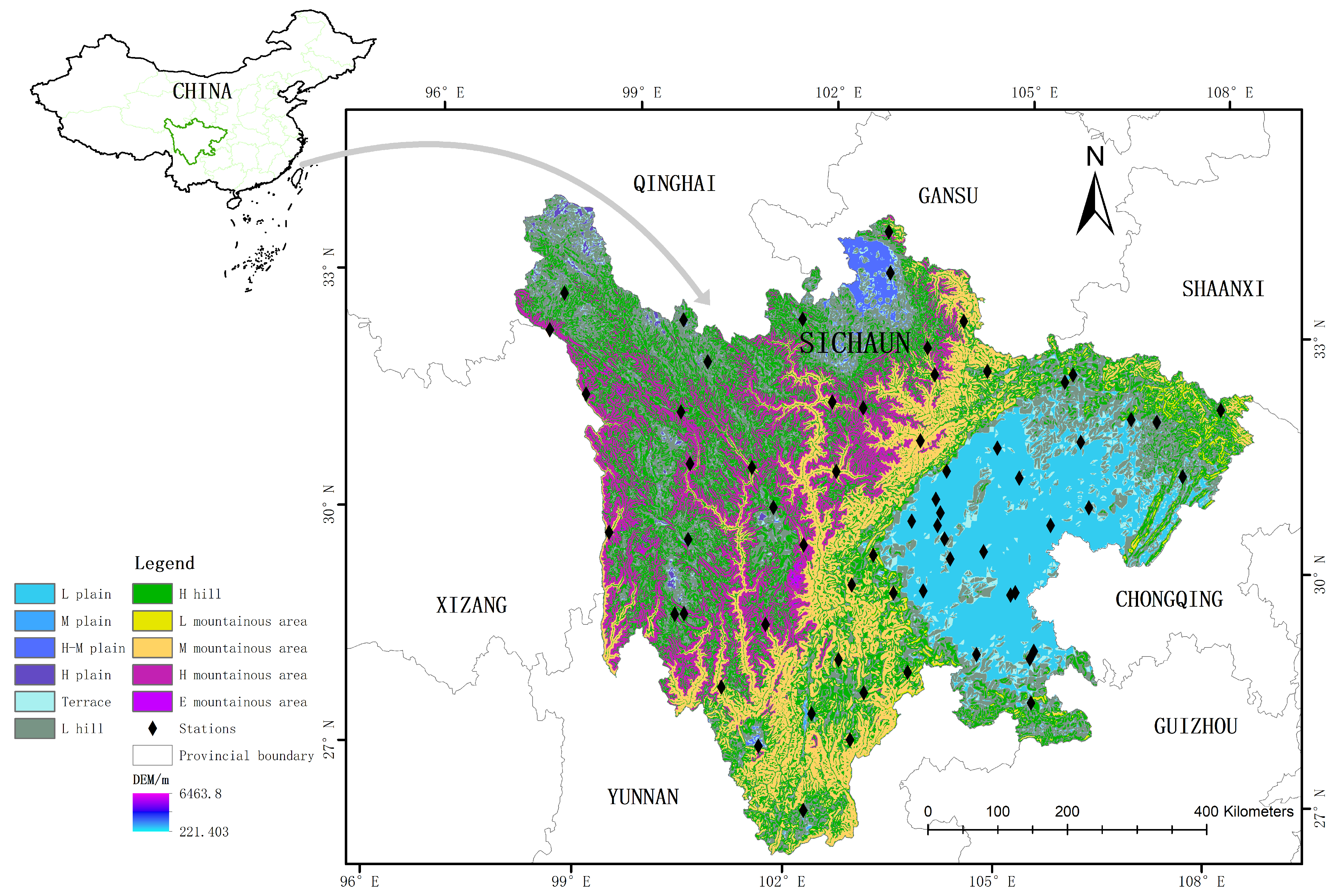
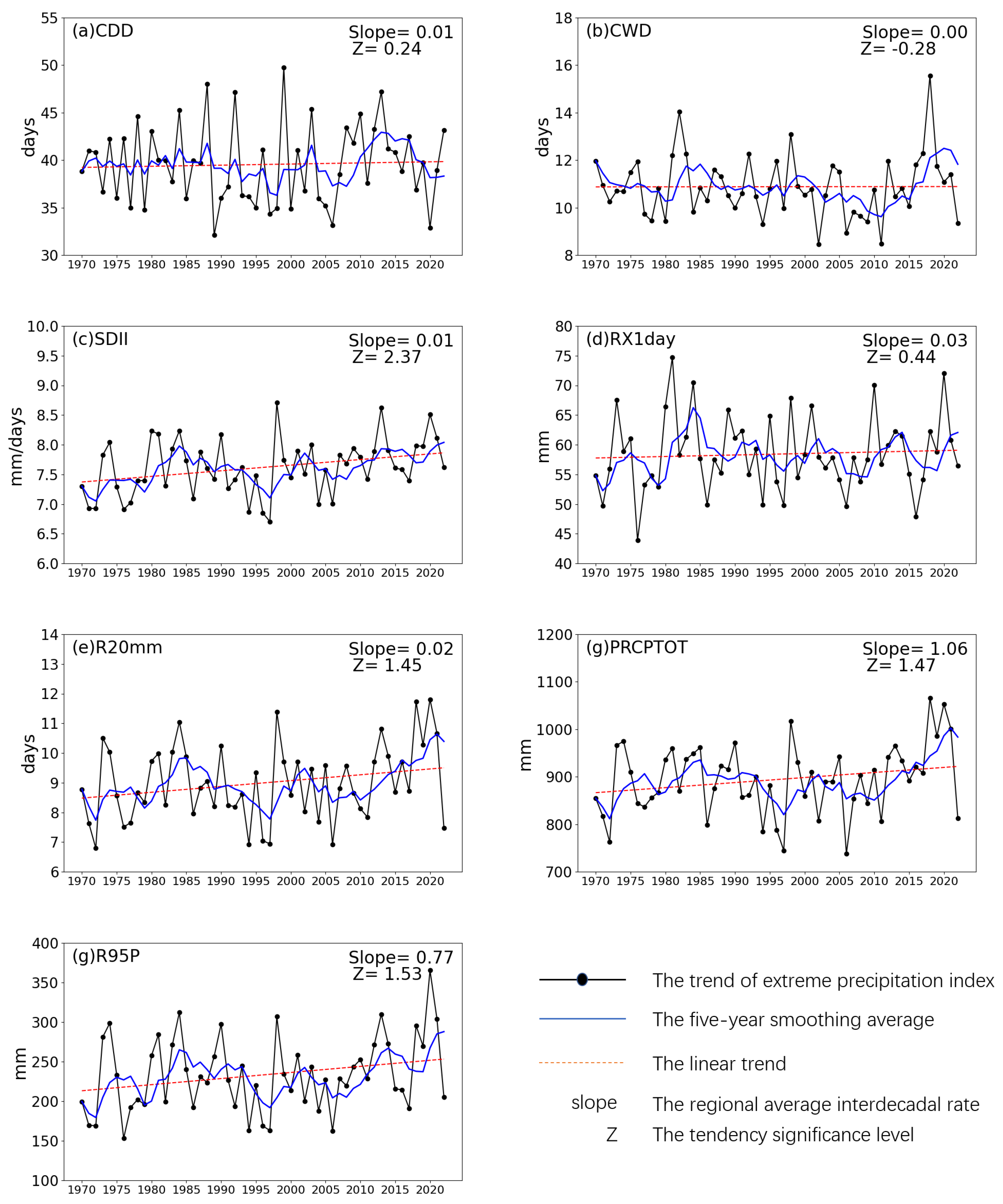
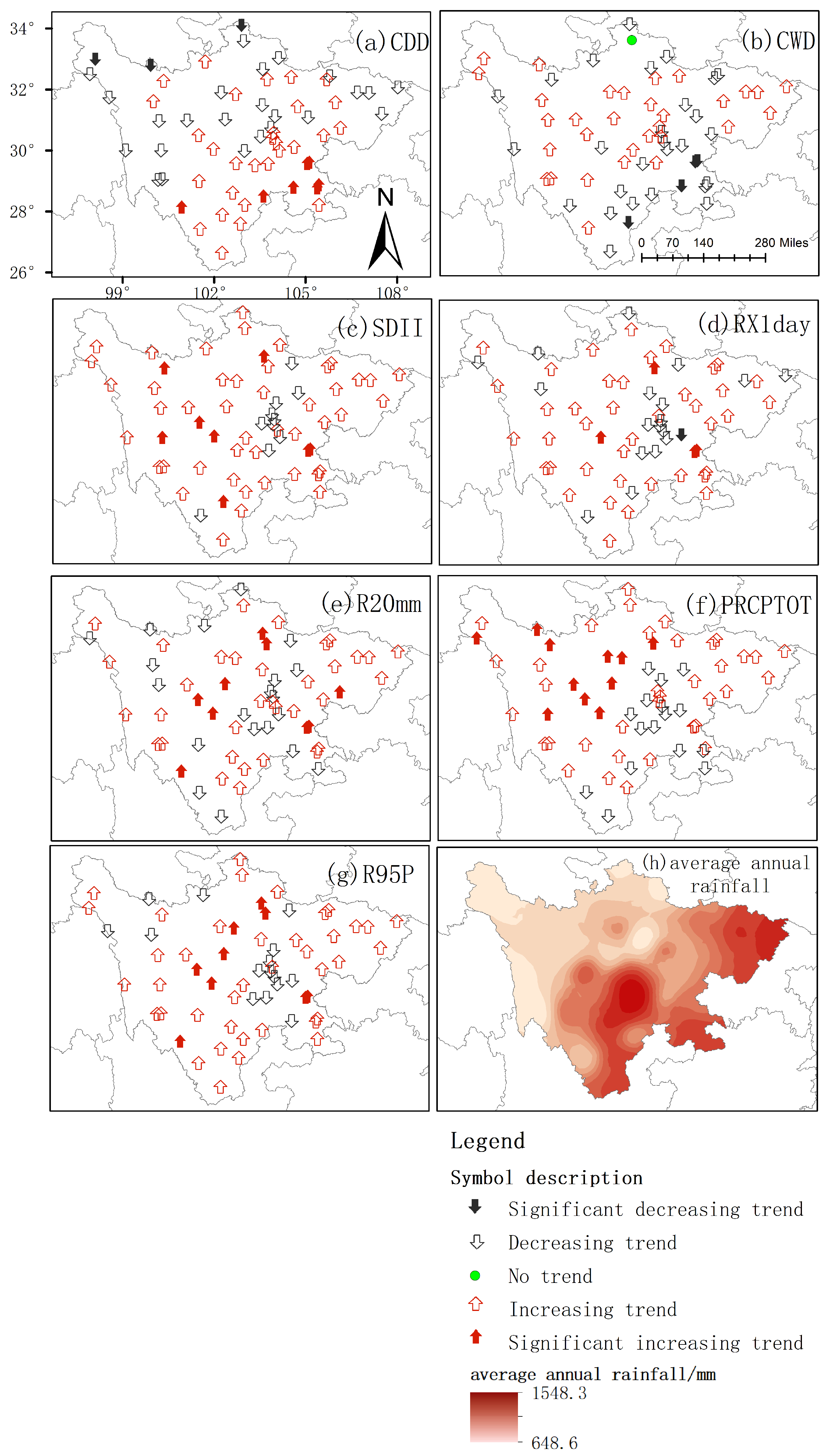
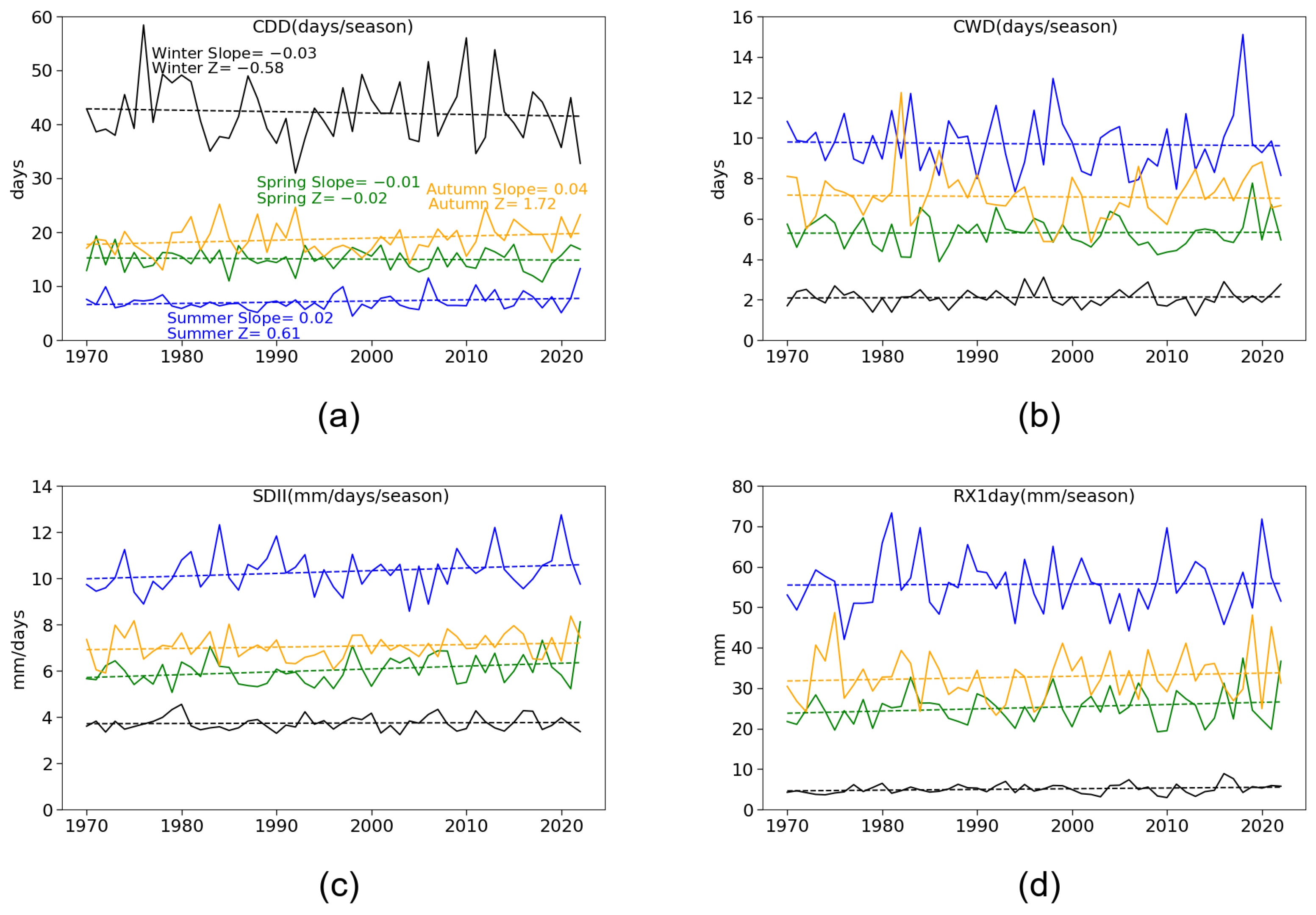

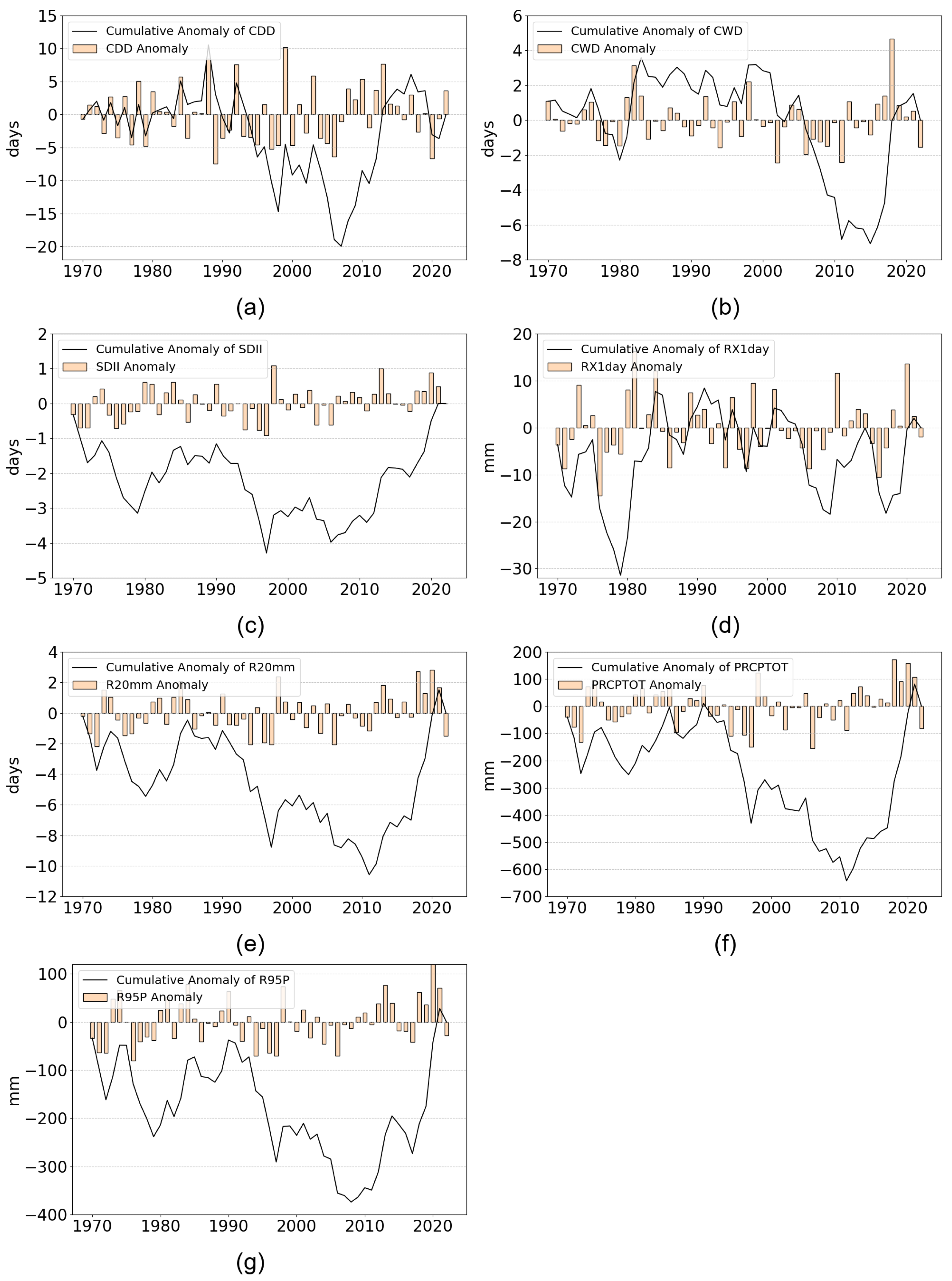

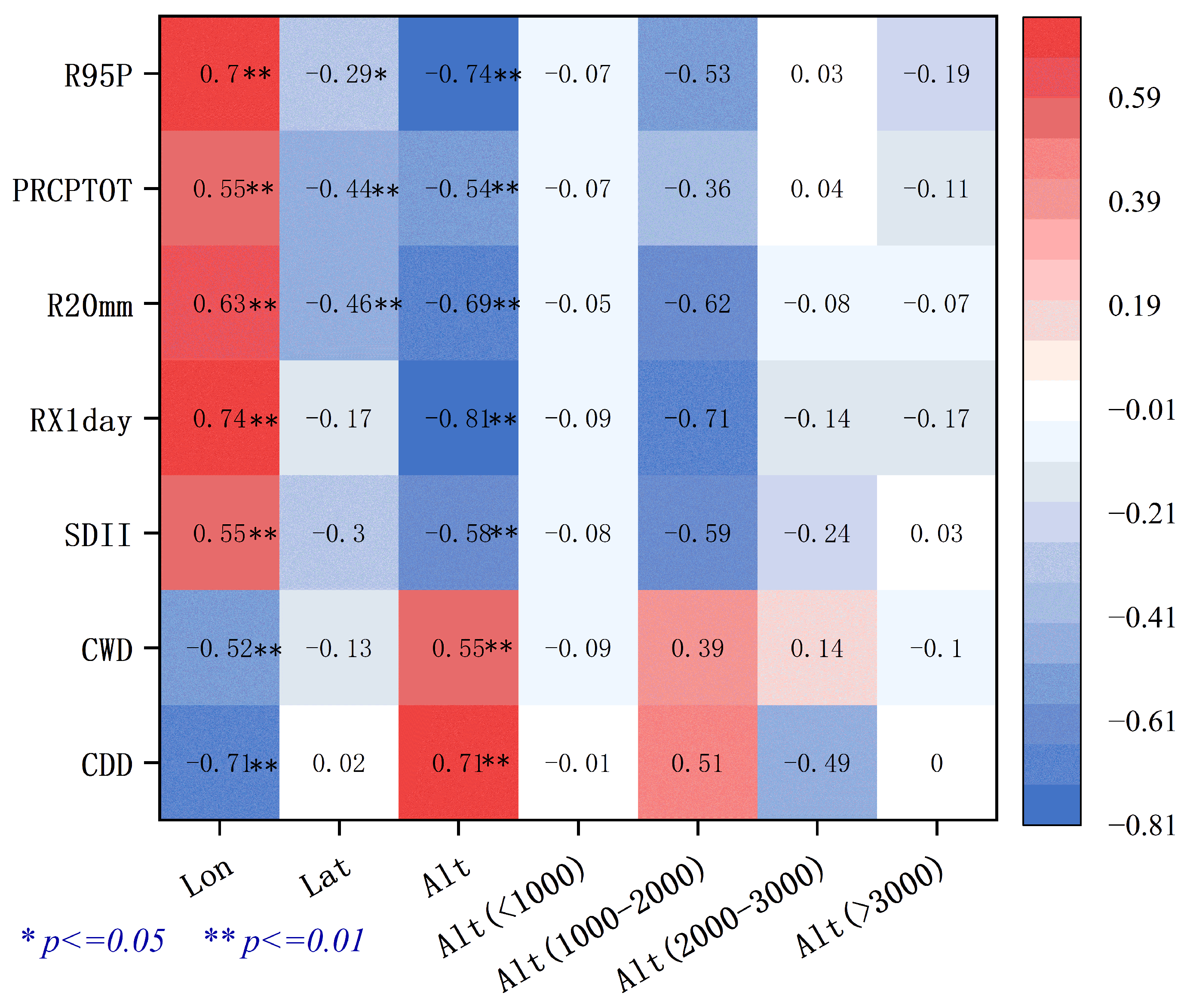
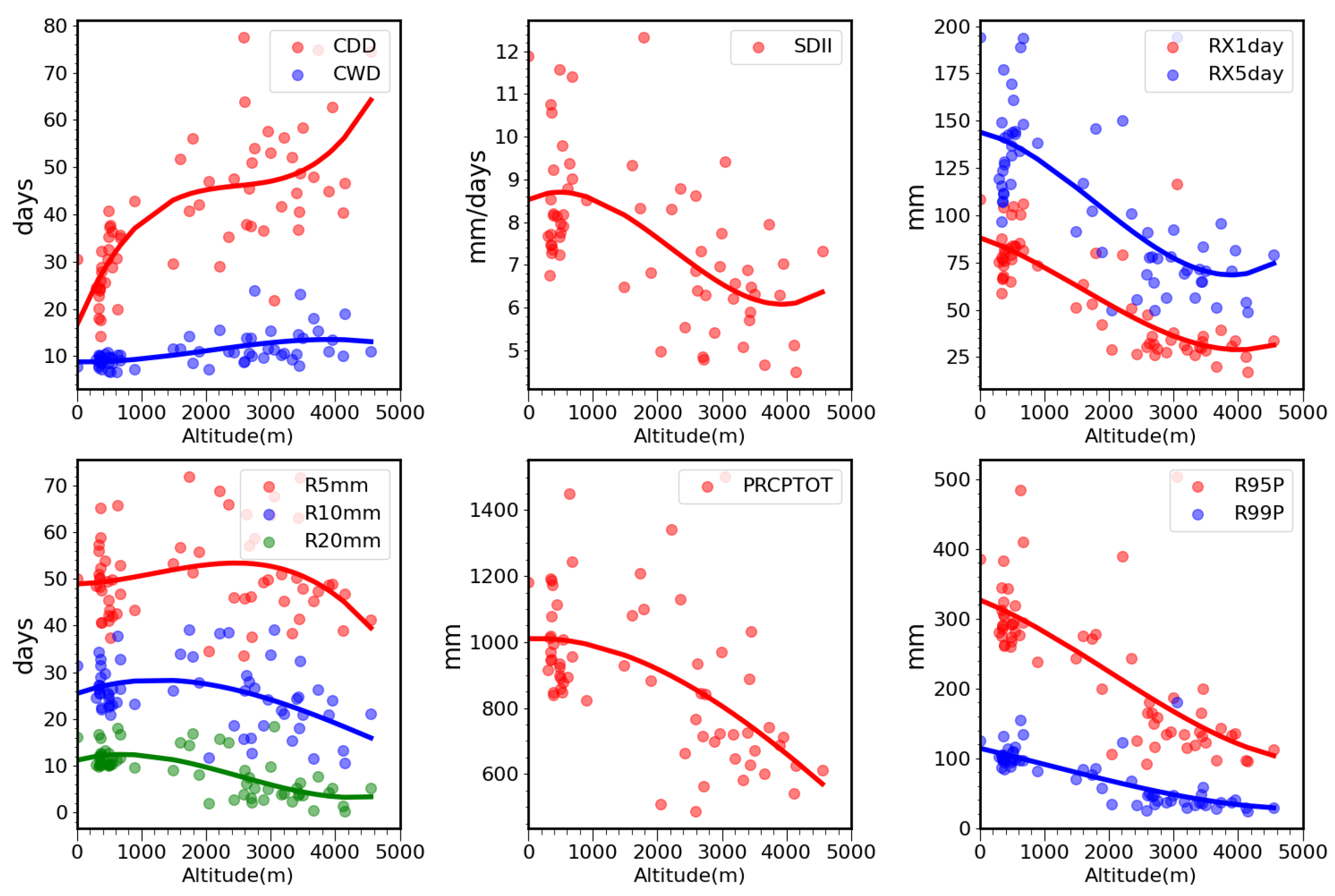
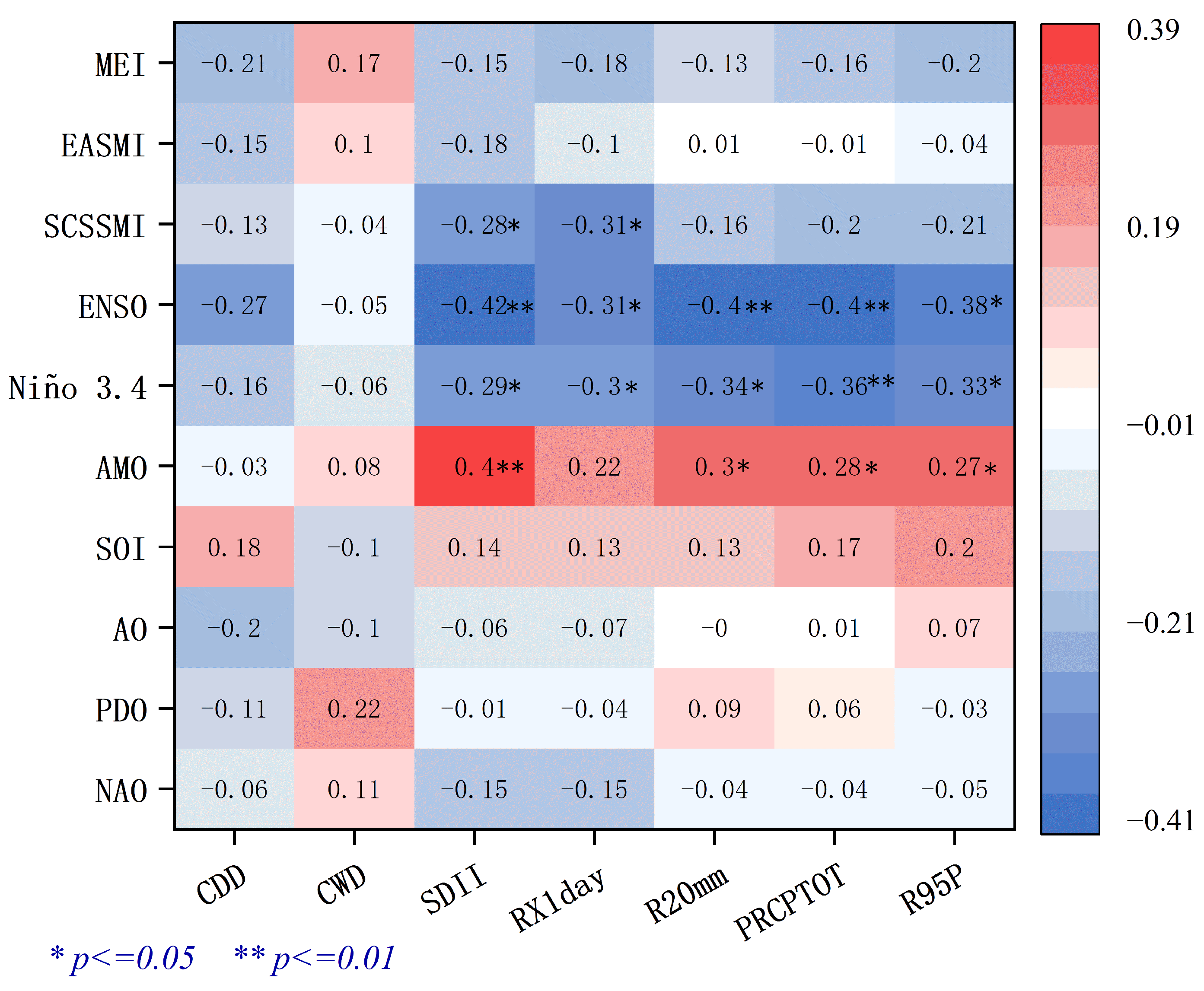



| Data | Description | Source |
|---|---|---|
| Daily precipitation | A new daily gridded precipitation dataset for the Chinese mainland based on gauge observations (CHM_PRE), Spatial resolution: 0.1° | National Tibetan Plateau Science Data Center (https://www.tpdc.ac.cn/home) (accessed on 20 November 2024) |
| Longitude | ||
| Latitude | ||
| Elevation | ||
| NAO | North Atlantic Oscillation | NOAA Physical Sciences Laboratory (PSL) (https://psl.noaa.gov/data/climateindices/list/) (accessed on 20 November 2024) |
| PDO | Pacific Decadal Oscillation | |
| AO | Arctic Oscillation | |
| AMO | Atlantic Multidecadal Oscillation | |
| Niño 3.4 | East Central Tropical Pacific SST | |
| SOI | Southern Oscillation Index | |
| MEI | Multivariate ENSO Index | |
| EASMI | East Asian Summer Monsoon Index | Publicly available dataset published by Prof. Jianping Li (http://lijianping.cn/dct/page/1) (accessed on 20 November 2024) |
| SCSSMI | South China Sea Summer Monsoon Index | |
| ERA5-Land | ERA5-Land monthly averaged data from 1950 to present. Horizontal resolution: 0.1° × 0.1° | European Centre for Medium-Range Weather Forecasts (ECMWF) (https://cds.climate.copernicus.eu/datasets) (accessed on 10 January 2025) |
| Number | Index | Description Name | Definition | Units |
|---|---|---|---|---|
| 1 | CDDs | Consecutive dry days | Maximum number of consecutive days when RR < 1 mm | days |
| 2 | CWDs | Consecutive wet days | Maximum number of consecutive days when RR ≥ 1 mm | days |
| 3 | SDII | Simple daily intensity index | Annual total precipitation divided by the number of wet days (defined as precipitation ≥ 1 mm) in a year | mm/days |
| 4 | RX1day | Max 1-day precipitation amount | Monthly maximum 1-day precipitation | mm |
| 5 | R20mm | Number of very heavy precipitation days | Annual count of days when precipitation ≥ 20 mm | days |
| 6 | PRCPTOT | Annual total wet-day precipitation | Annual total precipitation on wet days (RR ≥ 1 mm) | mm |
| 7 | R95P | Very wet days | Annual total precipitation when daily precipitation > 95th percentile | mm |
| Index | Units | Number of Rising Sites (Significant) | Number of Declining Sites (Significant) | Number of Non-Trending Sites |
|---|---|---|---|---|
| CDDs | days | 36 (7) | 27 (3) | 0 |
| CWDs | days | 31 (0) | 31 (4) | 1 |
| SDII | mm/days | 53 (8) | 27 (3) | 0 |
| RX1day | mm | 53 (8) | 10 (0) | 0 |
| R20mm | days | 43 (9) | 20 (0) | 0 |
| PRCPTOT | mm | 47 (11) | 16 (0) | 0 |
| R95P | mm | 48 (9) | 15 (0) | 0 |
| Index | CDD | CWD | SDII | RX1day | R20mm | PRCPTOT | R95P |
|---|---|---|---|---|---|---|---|
| Point of Mutation | 2008 (p > 0.05) | 2016 (p > 0.05) | 1998 | 1980 (p > 0.05) | 2012 | 2012 | 2009 |
| Index | CDD | CWD | SDII | RX1day | R20mm | PRCPTOT | R95P |
|---|---|---|---|---|---|---|---|
| H | 0.457 | 0.681 | 0.719 | 0.690 | 0.641 | 0.627 | 0.590 |
| D | 1.543 | 1.319 | 1.281 | 1.310 | 1.359 | 1.371 | 1.410 |
Disclaimer/Publisher’s Note: The statements, opinions and data contained in all publications are solely those of the individual author(s) and contributor(s) and not of MDPI and/or the editor(s). MDPI and/or the editor(s) disclaim responsibility for any injury to people or property resulting from any ideas, methods, instructions or products referred to in the content. |
© 2025 by the authors. Licensee MDPI, Basel, Switzerland. This article is an open access article distributed under the terms and conditions of the Creative Commons Attribution (CC BY) license (https://creativecommons.org/licenses/by/4.0/).
Share and Cite
Bai, L.; Liu, T.; Sha, A.; Li, D. The Spatiotemporal Fluctuations of Extreme Rainfall and Their Potential Influencing Factors in Sichuan Province, China, from 1970 to 2022. Remote Sens. 2025, 17, 883. https://doi.org/10.3390/rs17050883
Bai L, Liu T, Sha A, Li D. The Spatiotemporal Fluctuations of Extreme Rainfall and Their Potential Influencing Factors in Sichuan Province, China, from 1970 to 2022. Remote Sensing. 2025; 17(5):883. https://doi.org/10.3390/rs17050883
Chicago/Turabian StyleBai, Lin, Tao Liu, Agamo Sha, and Dinghong Li. 2025. "The Spatiotemporal Fluctuations of Extreme Rainfall and Their Potential Influencing Factors in Sichuan Province, China, from 1970 to 2022" Remote Sensing 17, no. 5: 883. https://doi.org/10.3390/rs17050883
APA StyleBai, L., Liu, T., Sha, A., & Li, D. (2025). The Spatiotemporal Fluctuations of Extreme Rainfall and Their Potential Influencing Factors in Sichuan Province, China, from 1970 to 2022. Remote Sensing, 17(5), 883. https://doi.org/10.3390/rs17050883





